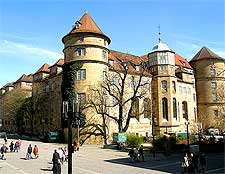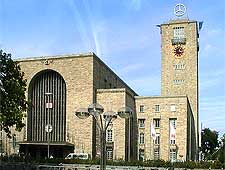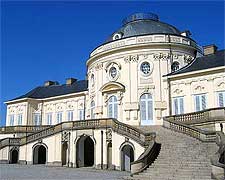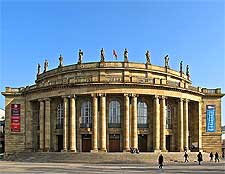Stuttgart History Facts and Timeline
(Stuttgart, Baden-Wurttemberg, Germany)

The earliest history of the Stuttgart area dates back to Roman times. A fortress was built in Cannstatt, nowadays one of the city's largest districts. In the centuries that followed the decline of the Roman Empire, this area found itself under the control of various rulers, including the Franks and the Carolingians.
It wasn't until the 10th century, however, that the roots of Stuttgart became visible. It's said that Duke Herzog Liudolf von Schwaben started a stud farm in an area of the Nesenbach Valley in 950 AD. Known as Stutengarten, its coat of arms is taken from those of the original farm. Historical records that date back to 1160 certainly mention a Hugo de Stuokarten.
From Medieval Town to Capital City
In the 13th century, the medieval town of Stuttgart was granted the status of city. A century later, it became the official residence of the Count of Wurttemberg and the town began to grow more quickly. By 1488, the city had become the official capital of the area. This period of Germany's history was particularly turbulent, and Stuttgart was not to escape unscathed. During the Thirty Years' War, rival groups vied for control here.

In 1805, Stuttgart emerged to become the capital of the Kingdom of Wurttemberg. The royal residence was enlarged and some of the city's grandest buildings were constructed soon after. These included both the State Gallery (Staatsgalerie) and the Konigsbau.
In 1818, King Wilhelm I inaugurated an annual celebration of the city's survival in the face of adversity and plague. Known as the Cannstatter Volksfest, it is still held today and is now said to be second only to the more famous Oktoberfest in
Munich. In 1871, Wurttemberg became part of the unified German Empire.

A Modern City Emerge
In the 19th century, the railway arrived in Stuttgart, bringing with it the opportunity to change the course of the city's history once and for all. Along with the railway came industrialisation. Bosch's invention of the spark plug and Daimler's development of the petrol engine were significant factors in the evolution of the city's economy. In fact, Gottlieb Daimler invented the car in his local Cannstatt workshop.
After the end of World War One, the Wurttemberg monarchy finally broke down. Eventually, the Free State of Wurttemberg was set up, with Stuttgart as its capital. During World War Two, most of Stuttgart's buildings were destroyed during Allied air raids. The old part of the city was particularly badly damaged during a raid that took place in September 1944.

Post-War Developments
Post-war planning has led to many of the city's historic buildings surviving to this day and numerous large parks were also preserved. Although it was hoped that Stuttgart would become the capital of the Federal Republic of Germany, created in 1949, it was not to be. Instead, since 1952, it has been the seat of government for the new State of Baden-Wurttemberg.
Today, Stuttgart has a population of around 600,000 and has grown to become the sixth-biggest city in the whole of Germany.
 The earliest history of the Stuttgart area dates back to Roman times. A fortress was built in Cannstatt, nowadays one of the city's largest districts. In the centuries that followed the decline of the Roman Empire, this area found itself under the control of various rulers, including the Franks and the Carolingians.
The earliest history of the Stuttgart area dates back to Roman times. A fortress was built in Cannstatt, nowadays one of the city's largest districts. In the centuries that followed the decline of the Roman Empire, this area found itself under the control of various rulers, including the Franks and the Carolingians. In 1805, Stuttgart emerged to become the capital of the Kingdom of Wurttemberg. The royal residence was enlarged and some of the city's grandest buildings were constructed soon after. These included both the State Gallery (Staatsgalerie) and the Konigsbau.
In 1805, Stuttgart emerged to become the capital of the Kingdom of Wurttemberg. The royal residence was enlarged and some of the city's grandest buildings were constructed soon after. These included both the State Gallery (Staatsgalerie) and the Konigsbau.
